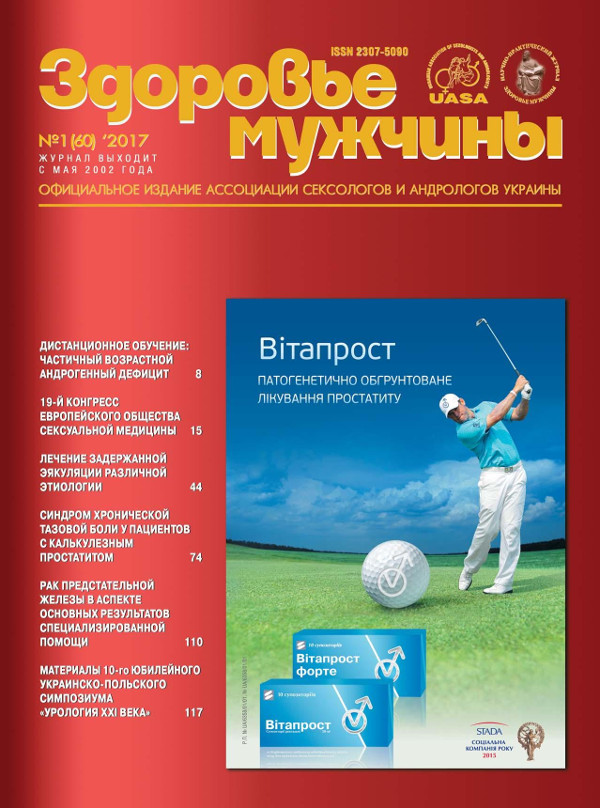Hematomas after the minimally invasive surgery upper urinary tract
##plugins.themes.bootstrap3.article.main##
Abstract
Materials and methods. 29 cases of pericardial hematomas after minimally invasive interventions in UTI have been analyzed. The average age of the patients was 49 years. Men were 52%, women – 48%. All patients are divided into two groups. The I group included 18 patients with complications in the treatment of urolithiasis using extracorporeal shock wave lithotripsy. The II group included 11 patients with complications with various endourological interventions.
Results. All patients underwent intensive therapy: infusion hemostatic antibacterial therapy. After stabilization of the patients' condition, dynamic observation was performed using laboratory and instrumental methods (ultrasound and intravenous urography). After the end of inpatient treatment (~21 days), follow-up was continued in outpatient settings with ultrasound monitoring at 3-6-9-12-18 months.
Conclusion. Risk factors for the development of perineal hematoma with minimally invasive interventions for UTI are the presence of concomitant hypertension, diabetes mellitus, atherosclerosis, obesity, primary and secondary coagulopathies in patients, and repeated sessions in a hard mode, which must be taken into account before minimally invasive interventions. Minimally invasive drainage with hematomas should be used in the presence of signs of their suppuration, open surgical treatment – in the presence of signs of recurrence of hematoma.
##plugins.themes.bootstrap3.article.details##

This work is licensed under a Creative Commons Attribution 4.0 International License.
Authors retain the copyright and grant the journal the first publication of original scientific articles under the Creative Commons Attribution 4.0 International License, which allows others to distribute work with acknowledgment of authorship and first publication in this journal.
References
Andersen J.N, Mogensen P. Extracorporeal shock wave lithotripsy of urinary calculi. Results from the first 306 patients treated at the Copenhagen Municipal Stone Center with a second generation lithotriptor //Scand. J. Urol. Nephrol. – Suppl. 1991. – 138. – Р. 19–24.
Collado Serra A., Huguet Perez J., Monreal Garcia de Vicuna F, et al. Renal hematoma as a complication of extracorporeal shock wave lithotripsy // Scand J. Urol. Nephrol. – 1999. – Vol. 33, No 3. – P. 171–5.
Dominguez Molinero J.F., Arrabal Martin M., Mijan Ortiz J.L. et al. [Renal hematomas secondary to extracorporeal shockwave lithotripsy] // Arch Esp Urol. – 1997. – Vol. 50, No 7. – P. 767–71.
Gordon H, Mather J. Ureteral and bledder stone SWL: lessons lear ned from an individual physician series // J. Endourol. – 1997. – Vol. 11, Suppl. 1. – p. 12–16, S. 172.
Schmiedt E., Chaussy C. Extracorporeal shock wave lithotripsy (ESWL) of kidney and ureteric stones // Int. Urol. Nephrol. – 1984. – Vol. 16, No 4. – Р. 273–283.
Torrecilla Ortiz C., Matias Lopez J.J., Contreras Garcia J., et al. [Renal hematoma after shockwave extracorporeal lithotripsy] // Actas Urol. Esp. – 1997. – Vol. 21, No 8. – P. 752–757.
von der Recke P, Nielsen MB, Pedersen JF. Complications of ultrasound-guided nephrostomy: a 5-year experience // Acta Radiol. – 1994. – Vol. 35. – P. 452–454.
Лопаткин Н.А., Дзеранов Н.К. Анализ развития осложнений дистанционной ударноволновой литотрипси, их профилактика и лечение // Матер. Второго Всероссийского симпозиума по литотрипсии. – Пермь, 1994. – С. 186–194.





